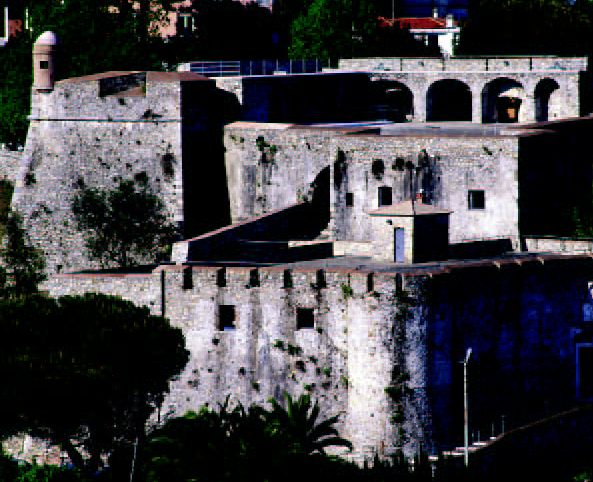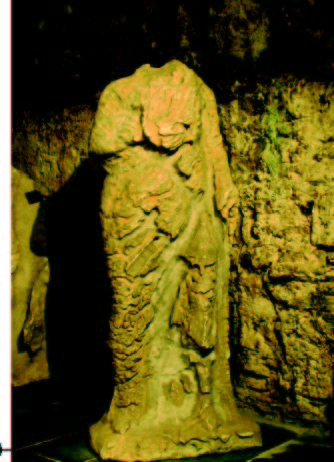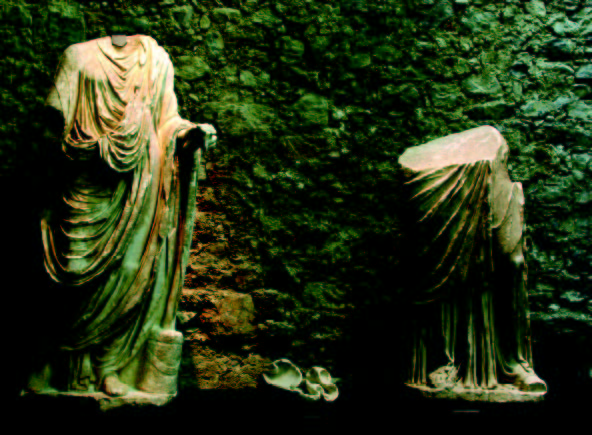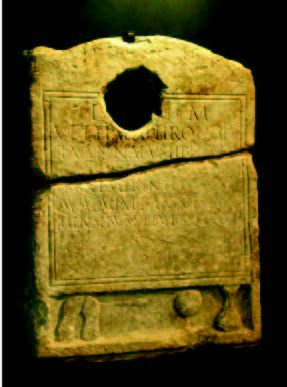

museo archeologico del castello di san giorgio
Ilaria Buselli |
 |
All’interno della fortificazione di San Giorgio, contenitore di grande importanza monumentale, è allestito il Museo Archeologico che espone le civiche collezioni, raccolte a partire dall’Ottocento nel territorio afferente la città della Spezia e in Lunigiana. Il percorso espositivo permette di effettuare una lettura diacronica dell’evoluzione culturale nel territorio: dalle statue stele lunigianesi dell’età del Rame e del Ferro ai reperti dei castellari dell’età del Bronzo, abitati d’altura delle antiche popolazioni liguri, fino alle sepolture ad incinerazione della tarda età del Ferro. Il secondo livello del Museo ospita il ricco nucleo di materiali provenienti prevalentemente dalla colonia di Luni, che testimoniano la continuità dell’insediamento in epoca romana e altomedievale. Una grande sala polifunzionale è destinata a mostre temporanee, conferenze, convegni e laboratori didattici. |
| The Archeological Museum is located inside the San Giorgio fortification, a site of great monumental significance. It hosts the civic collections which have been brought together since the 19th century in both the La Spezia territory and Lunigiana. The exhibition routing enables to carry out a diachronic reading of the cultural evolution of such territory: from the Lunigiana stelae-statues of the Copper and Iron Ages, to the Bronze Age finds of the “castellari” (height housings of the ancient populations of Liguria), up to the burials and incinerations of the late Iron Age. The second level of the Museum hosts the rich nucleus of materials coming mostly from the Luni colony, which give evidence of the continuity of such settlement in the Roman and early medieval ages. A large multi-functional hall is allocated to temporary exhibitions, conferences, conventions and pedagogical workshops. | |
MUSEO
ARCHEOLOGICO DEL CASTELLO DI SAN GIORGIO Via XXVII Marzo 19121 La Spezia, Italy tel. +39 0187 751142 www.castagna.it/sangiorgio |
 |
Statua
funeraria / Funerary statue |
La
statua panneggiata acefala, frammentaria e fortemente corrosa dall’azione
dell’acqua è difficilmente leggibile, ma si ritiene che sia
femminile: il corpo, piuttosto sottile, indossa il chitone ed è
avviluppato nel mantello fasciante. Il luogo di rinvenimento non è
sicuro, ma è probabile che provenisse da una zona esterna alle
mura urbane e fosse quindi di destinazione funeraria. Al di fuori The acephalous draped statue, in fragments and severely corroded by the action of water is of difficult interpretation, still it is believed to be female: the somewhat thin body wears the chiton and is wrapped in the cloak. The place of finding is not certain, though it is likely to be an area outside the town walls and therefore of funerary destination. The necropolis of Luni stretched outside the enceinte, along the Aurelia/Aemilia Scauri Way; the funeral monuments where most diversified, and some of them of aedicula type, were decorated with the statues of the defunct. |
| Ilaria
Buselli Nata a / Born in La Spezia, 1981 Vive e lavora a / She lives and works in La Spezia sara81_s@libero.it |
Senza
titolo , 2004 |
La memoria di un corpo, le sue tracce attaccate dal tempo. Carne che si fa pietra per eternarsi e Chronos, inclemente, che ostacola la volontà dell’Arte di essere perpetua. Lo sguardo che Ilaria Buselli getta sull’opera del passato genera altre opere del passato: due oggetti, un tempo due corpi, una statua, resa mutila e spogliata, ed una solarizzazione fotografica di Man Ray, ambedue solo un fragile simulacro di una presenza femminile, ed ambedue aggredite dalla materia cromatica amniotica in cui fluttuano, non solo sfondo intriso dei toni mortiferi del rosso e del nero, ma emblema stesso del tempo, della perdita della memoria, di una fine procrastinabile forse, ma evitabile mai. Ma l’Arte genera altra Arte, e quella impronta della pianta del Museo resta come un segno di questa Volontà. The memory of a body, its traces attacked by Time. Flesh which turns into stone, and the inexorable Chronos which hinders the will of Art of being perpetual. The glance Ilaria Buselli casts on the work of the past generates other works of the past: two objects, once two bodies. A mutilated, stripped statue and a photographic solarization by Man Ray. They both are but a frail simulacrum of a feminine presence; they both are aggressed by the amniotic chromatic matter they float in; not only a background soaked in the deadly tones of red and black, but at the same time an emblem of memory loss, of an end which can perhaps be deferred, but never escaped. Yet, Art generates other Art, and this print of the Museum plant remains as a sign of such Will. Matteo Sara |
|
 |
Statua
di togato / Togated statue |
La statuaria romana seguiva alcune tipologie di rappresentazione che si ripetevano con notevole frequenza: le donne indossano il chitone coperto dal mantello, gli uomini la toga. Il frammento di statua femminile adotta modelli di origine greca. La statua acefala maschile con toga rappresenta un personaggio che tiene in mano un volumen, rotolo di papiro, aperto e ai suoi piedi è rappresentato lo scrinium, contenitore per rotoli. Il personaggio, verosimilmente un membro dell’élite locale, sta declamando un testo e in questo senso è significativa l’originaria collocazione della statua: il teatro di Luni. Roman statuary was following some typologies of representation which repeated themselves with remarkable frequency: women wear the chiton, covered by the cloak; men wear the toga. The fragment of female statue adopts models of Greek origin. The acephalous masculine statue with the toga represents a character holding in his hands a volumen, an open roll of papyrus, and at his feet there is a scrinium, a box containing the rolls. The character, most likely a member of the local elite, is declaiming a text and in this sense the original location of the statue (Luni’s theater) is significant. |
| Marco
Dazzi Nato a / Born in Carrara, 1974 Vive e lavora a / He lives and works in Ortonovo (SP) skintwo74@libero.it www.marcodazzi.net |
Teorica
ricostruzione , 2004 |
Le
statue romane rilette da Marco Dazzi nelle sue elaborazioni digitali di
fotografie sono occasione
The Roman statues reinterpreted by Marco Dazzi in
his digital processing of photographs are an Matteo Sara |
|
 |
Stele
di / Stela of Vettia Aphrodisia |
La stele funeraria di età romana è dedicata a Vettia Aphrodisia, morta a soli venti anni e compianta sposa dolcissima di Sesto Anneo Liberale. La scena figurata sotto lo specchio epigrafico fornisce indicazioni sugli interessi della defunta, rappresentando alcuni oggetti riferibili al mondo muliebre: pettine, specchio, solae, spillone per capelli e vasetto porta unguenti. Nelle stele di Luni i motivi relativi alla cura della bellezza si ripetono con tale frequenza da costituire una possibile testimonianza della posizione particolare della donna nella società locale; questi stessi oggetti sono tipici elementi dei corredi funebri femminili. The
funerary stelae of Roman age is dedicated to Vettia Aphrodisia,
sweet wife of Sesto Anneo Liberale, who prematurely died at twenty. The
scene which is shown under the epigraphic mirror supplies indications
on the interest of the defunct by representing some objects of woman’s
world: comb, mirror, solae, hairpin and cream jar. The motives
relevant to the care of beauty repeat |
| Elena
Guidotti Nata a / Born in Sarzana (SP), 1979 Vive e lavora a / She lives and works in Fosdinovo (MS) |
Elena,
2004 |
Il
linguaggio di Elena Guidotti, sia che esprima una pittura timbrica che
attinge alle avanguardie Elena Guidotti’s language, both when it expresses a tone-colour painting which draws the lexical elements of the composition on the historical vanguards and when it resorts to the graphic experimentation with the most diversified means, can always be taken back to the interaction of the word, even interpreted as a pure sign, and the figurative element experienced as an alphabet to trace a sort of autobiography out of images and colours. This is how Elena talks about herself, by weaving self-portraits through a patient handicraft-presswork. Echoes of her canvas search unite to different thoughts, emotions and memories to create on the light, fragile, translucent fabric a ponderal rival project to the tombstone, whose funerary valence is swept away by the chromatic explosion of the central element. Matteo Sara |
|